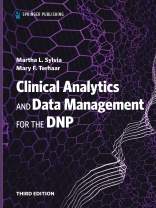Praise for the first edition:
‘DNP students may struggle with data management, since their projects are not research but quality improvement, and this book covers the subject well. I recommend it for DNP students for use during their capstone projects.’ Score: 98, 5 Stars
— Doody’s Medical Reviews
This unique text and reference—the only book to address the full spectrum of clinical data management for the DNP student—instills a fundamental understanding of how clinical data is gathered, used, and analyzed, and how to incorporate this data into a quality DNP project. The new third edition is updated to reflect changes in national health policy such as quality measurements, bundled payments for specialty care, and Advances to the Affordable Care Act (ACA) and evolving programs through the Centers for Medicare and Medicaid Services (CMS). The third edition reflects the revision of 2021 AACN Essentials and provides data sets and other examples in Excel and SPSS format, along with several new chapters.
This resource takes the DNP student step-by-step through the complete process of data management, from planning through presentation, clinical applications of data management that are discipline-specific, and customization of statistical techniques to address clinical data management goals. Chapters are brimming with descriptions, resources, and exemplars that are helpful to both faculty and students. Topics spotlight requisite competencies for DNP clinicians and leaders such as phases of clinical data management, statistics and analytics, assessment of clinical and economic outcomes, value-based care, quality improvement, benchmarking, and data visualization. A progressive case study highlights multiple techniques and methods throughout the text.
New to the Third Edition:
- New Chapter: Using EMR Data for the DNP Project
- New chapter solidifies link between EBP and Analytics for the DNP project
- New chapter highlights use of workflow mapping to transition between current and future state, while simultaneously visualizing process measures needed to ensure success of the DNP project
- Includes more examples to provide practical application exercises for students
Key Features:
- Disseminates robust strategies for using available data from everyday practice to support trustworthy evaluation of outcomes
- Uses multiple tools to meet data management objectives [SPSS, Excel®, Tableau]
- Presents case studies to illustrate multiple techniques and methods throughout chapters
- Includes specific examples of the application and utility of these techniques using software that is familiar to graduate nursing students
- Offers real world examples of completed DNP projects
- Provides Instructor’s Manual, Power Point slides, data sets in SPSS and Excel, and forms for completion of data management and evaluation plan
विषयसूची
Contributors
Foreword for the Third Edition
Preface
Instructor Resources
PART I: INTRODUCTION
Chapter 1. Introduction to Clinical Data Management
Chapter 2. Analytics and Evidence-Based Practice
PART II: DATA PLANNING AND PREPARATION
Chapter 3. Using Data to Support the Problem Statement
Chapter 4. Preparing for Data Collection
Chapter 5. Secondary Data Collection
Chapter 6. Primary Data Collection
Chapter 7. Using EHR Data for the DNP Project
PART III: PREPARING FOR PROJECT IMPLEMENTATION
Chapter 8. Determining the Project Measures
Chapter 9. Using Statistical Techniques to Plan the DNP Project
Chapter 10. Using Workflow Mapping to Plan the DNP Project Implementation
Chapter 11. Developing the Analysis Plan
Chapter 12. Best Practices for Submission to the Institutional Review Board
PART IV: IMPLEMENTING AND EVALUATING PROJECT RESULTS
Chapter 13. Creating the Analysis Data Set
Chapter 14. Exploratory Data Analysis
Chapter 15. Outcomes Data Analysis
Chapter 16. Summarizing the Results of the Project
Chapter 17. Ongoing Monitoring
PART V: KEY COMPETENCIES FOR DNP PRACTICE
Chapter 18. Data Governance and Stewardship
Chapter 19. Value-Based Care
Chapter 20. Nursing Excellence Recognition and Benchmark Programs
PART VI: ADVANCED ANALYTIC TECHNIQUES
Chapter 21. Data Visualization
Chapter 22. Risk Adjustment
Chapter 23. Big Data, Data Science, and Analytics
Chapter 24. Predictive Modeling
Index
लेखक के बारे में
Mary F. Terhaar, Ph D, RN, ANEF, FAAN, is Associate Dean for Graduate Programs at the Fitzpatrick College of Nursing at Villanova University. She is a respected leader in translation, education, and team collaboration. Across 40 years of leadership spanning diverse systems, roles, and clinical services; she has framed problems as challenges, built high-functioning teams with diverse talents, and led development and execution of replicable solutions. Dr. Terhaar has authored or co-authored more than 70 manuscripts and chapters, as well as two broadly adopted texts on translation, evaluation, and DNP education. She is sought as a consultant on curriculum design and continuous improvement in nursing education and provides support to programs working to deliver high impact, rigorous education. She is an active site visitor and team leader for the Commission on Collegiate Nursing Education. Dr. Terhaar has advanced DNP education by creating processes, curricula, and resources which guide faculty and students across the nation and in five countries to produce outcomes. The pioneering work of teams she has led provides guidance for IRB submission, scholarly writing, data management, translation, multiple significant practice challenges, and now entry and success in doctoral education for nurses on the rise. All are increasingly included in curricula which prepare graduates to meet the Quadruple Aim. Dr. Terhaar has led a series of programs to increase diversity in the workforce by increasing diversity in graduate and undergraduate education. Most recently, she developed and lead an innovative program to increase diversity and belonging among undergraduate nursing students in collaboration with the Independence Blue Cross Foundation, and North Philadelphia high schools. Dr. Terhaar is co-founder of an innovative program that helps prospective students remove barriers to entering doctoral study, which has increased successful applications across diverse groups of nurses. She also developed a post-doctoral program for DNPs which increased dissemination, socialization, collaboration, and impact. She has helped to increase the caliber and rigor of scholarship produced by DNPs, appropriate submissions to IRBs, reliability of data and means testing, successful publications, and outcomes from DNP projects.












